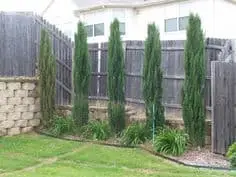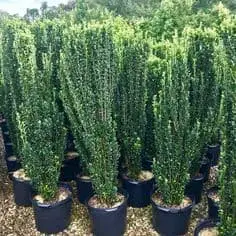Contents
Sky Pencil Holly, otherwise known as Ilex Crenata is a beautiful shrub to have around your home. It gets its name ‘Sky Pencil Holly’ from the fact that it grows really tall, narrow, and columnar like a pencil. This plant can grow to very tall heights ranging from 2ft. and 8ft. It is similar to boxwoods in appearance and many gardeners love to use it for borders or lush edges when landscaping. So if you’re interested in growing this shrub, keep reading to learn more about its origin as well as how to care for it.
 Source : Pinterest
Source : Pinterest
Origin of the Sky Pencil Holly
The Sky Pencil Holly originated from Japan but it is also native to several other Asian regions such as Korea and Coastal China. It was first discovered growing in the wild by Norihiro Shibamichi (not much is known about him at the moment) on Mt Daisen in Honshu, Japan. He took cuttings of the plants to Dr. Masato Yokoi, a notable author, and collector of various variegated plants. Later on, in 1985, Dr. Yokoi shared the plant’s samples with Sylvester March of the U.S. National Arboretum and Frederick Darke of Longwood Gardens in Pennsylvania. It was discovered holly variety and has since been dubbed the ‘Japanese holly’.
They found out that the plant has been carefully cultivated for years they categorized it as an evergreen broadleaf shrub and a member of the boxwood evergreens family. In 1992, the National Arboretum released cuttings to the nursery trade, and ever since gardeners all over the world have been planting it.
The Japanese holly is made distinct by its dark green, rounded, glossy leaves that are characteristically only slightly longer than an inch. In the late spring, small white four-petalled flowers bloom which tend to attract bees and other pollinators. These flowers eventually become rounded, small, dark fruits. The Sky Pencil Holly grows rather slowly. It grows at about six to twelve inches on average each year and the best time to plant it is either in the fall or spring.
Growing the Japanese Holly
 Source : Pinterest
Source : Pinterest
When growing the Japanese holly, it is important to remember that it is a fastigiate. A fastigiate is a tree or shrub that grows its branches parallel to the main stem. So why is this important? This unique piece of information is important because it tells you that its shape when growing can be problematic.
Although it is used to create narrow hedges, this effect requires very close spacing. The narrow form is used to accentuate landscapes in strategic positions like the end of a border or entryways or any other gap fitting for vertical accents. They can also be grown in containers and as a container plant can be used as a vertical marker.
Here are some conditions to be met when growing Sky Pencil Holly.
Growth Temperature: When planting the Sky Pencil Holly in a container, make sure the plants are protected in the winter because its roots can be winterkilled if the temperature dips far below 20oF.
Soil pH: Sky Pencil holly favors a slightly acidic soil with a pH ranging from 4.5 to 6.5 for its optimum growth. This way they look their best as alkaline soils can change the colors of their leaves to a pale green shade or even yellow.
Growth Seasons: The shrub is best planted during the fall or spring.
Sunlight Exposure: The plant favors full to partial exposure to sunlight.
Soil: A well-drained soil with a good base of organic matter will do.
USDA zone: Sky Pencil hollies are best grown in USDA zones 6 to 9. When grown in zone 6, it’ll need protection from harsh winds. It is also fairly drought resistant and can tolerate drought for short periods when established, but it is not recommended to allow prolonged exposure to draught.
Planting Sky Pencil Holly
To plant the Japanese Holly, simply dig a planting hole as deep as the root ball. Making the hole two to three times wider than the root ball. Next, you mix the fill dirt with some compost especially if your soil type is heavy clay or sand. While backfilling the hole, apply pressure with your foot periodically to get rid of all air pockets.
After planting water deeply, put in more fill dirt once the soil begins to settle. Apply between 4cm (2 in.) to 10cm (4 in.) of organic mulch around the root zone to ensure the soil retains enough moisture needed for the growth of the plant. Also, note that the Sky Pencil holly won’t need any fertilizer until the first spring after it’s been planted.
Finally, when planting the Japanese holly, you should know that it does not have an invasive root structure, therefore it can be planted in containers with no problems springing up. Also, whenever you plant them, you must ensure that they are planted at least five feet away from any home structure. Believe it or not, this is a standard guideline for most foundation plantings.
Finally, the sky pencil holly has a slow growth rate and if you intend to grow them to a tall height they should be pruned occasionally to create a thick base that can bear its weight.
Good to Read : Grow Olive Trees from Cutting
Want to know more about gardening ?
Fill in your email address in the form below and you'll receive all the latest updates directly in your in-box.
Thank you for subscribing.
Something went wrong.